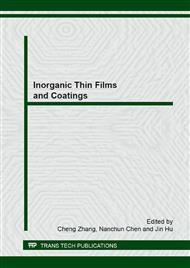p.214
p.220
p.224
p.229
p.234
p.238
p.243
p.247
p.252
Structure Characterization and Hydrophilic Property of S+Ce Co-Doped TiO2 Nanocomposite Film
Abstract:
The S+Ce co-doped TiO2 nanocomposite films deposited on glass substrate had been synthesized by the sol–gel dip-coating method. The as-synthesized samples were characterized using X-ray photoelectron spectroscopy (XPS), atomic force microscopy (AFM) and ultraviolet-visible (UV-vis) absorption spectra analysis technologies. The surface morphology and surface chemical composition of the S+Ce co-doped TiO2 nanocomposite film had been primarily investigated. The results shows that the properties of doped TiO2 thin films with different ions have close relations with the intrinsical properties of S and Ce doped ions, the absorption edge shifted towards visible light region and the water contact angle of the surface of the nanocomposite films with the water droplet was only 6°, indicating that the S+Ce co-doped TiO2 nanocomposite film showed promising applications in the self-cleaning and other potential fields.
Info:
Periodical:
Pages:
234-237
Citation:
Online since:
January 2013
Authors:
Keywords:
Price:
Сopyright:
© 2013 Trans Tech Publications Ltd. All Rights Reserved
Share:
Citation:


